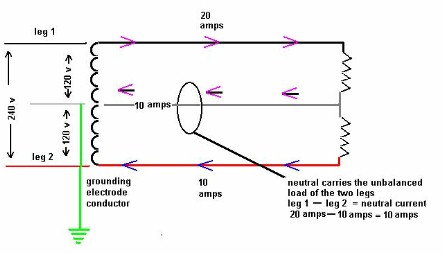This diagram may also help. The neutral conductor carries the unbalanced current difference flowing on each hot leg. If you had say exactly 30 amps flowing on each hot leg, the neutral current would be zero.
In a residential application, you are allowed to reduce the service neutral size one or two gauges because you don't get all the load in a house being drawn on one hot leg only. Can save a lot on the cost of copper.
The 2nd diagram illustrates an open neutral. Not the best image but all I could find in a quick search. In an RV, instead of light bulbs, any 120 volt items (microwave, AC, TV, appliances, etc.) will end up in series with 240 volts across them.
Of note is that if you have a 3-wire 120/240 volt power cord, the current flows sum to zero and the magnetic fields cancel each other out.


The next class discussion will be on 120/208 volt 3 phase power, lol:




